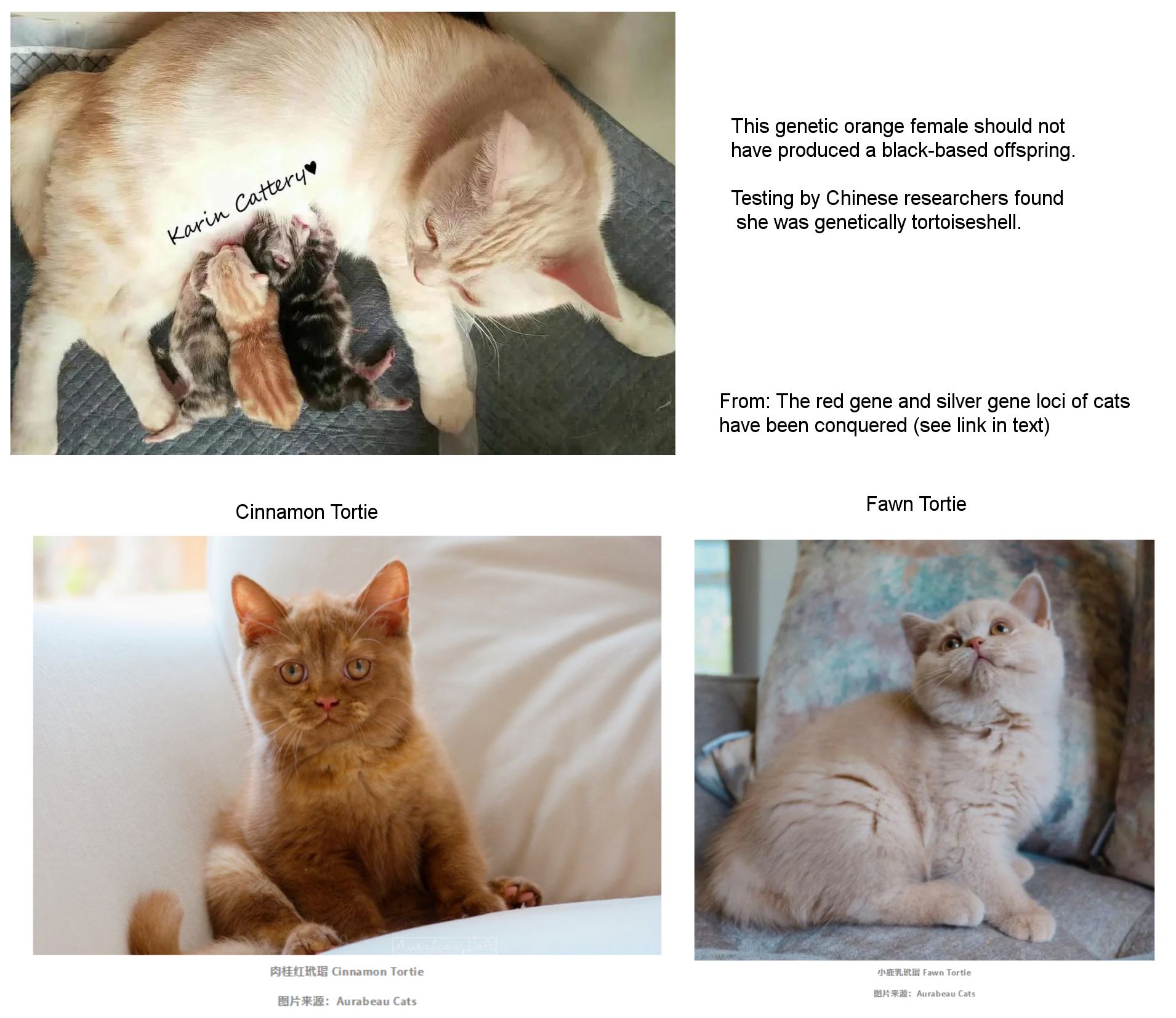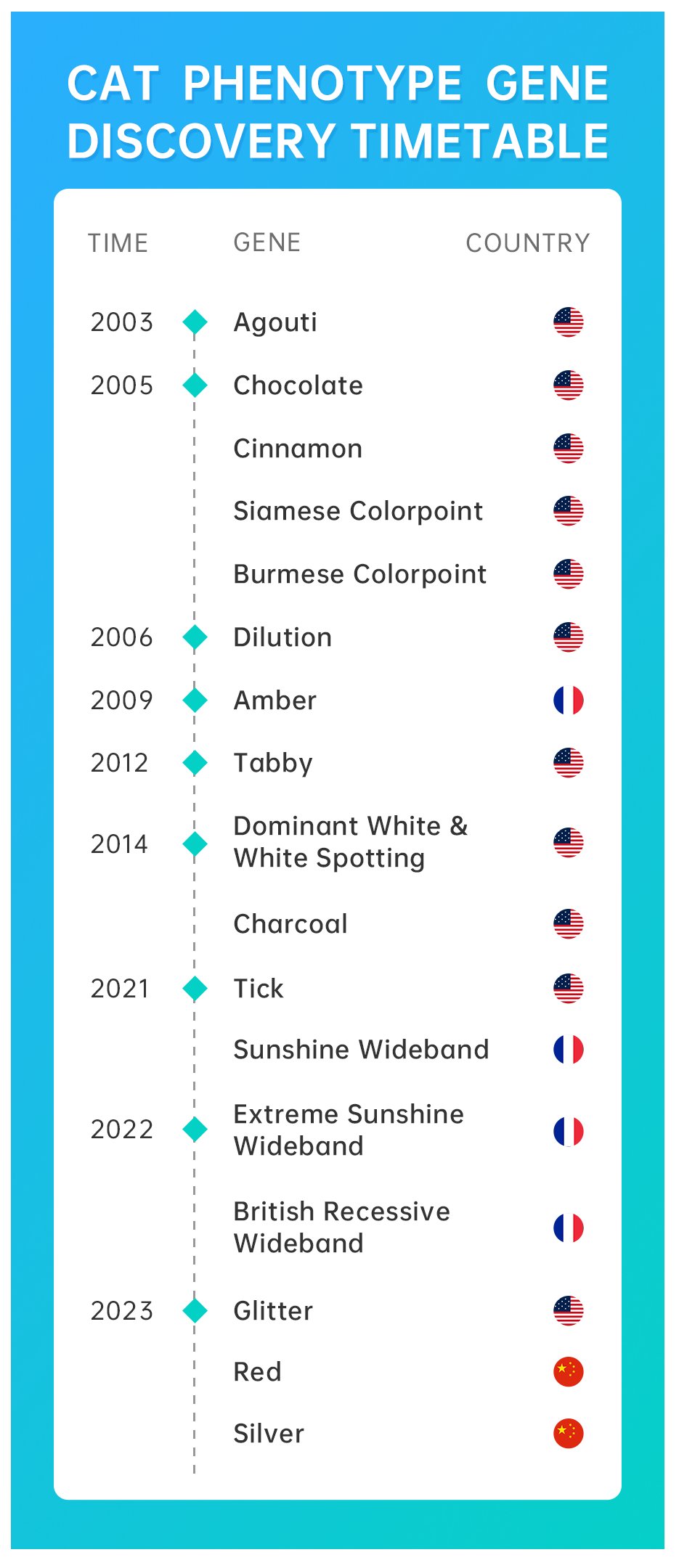
RED (ORANGE) GENE
Although a genetic test has been available from Petgeno, the scientific papers abut the orange gene in cats did not appear until late November 2024 (pre-prints in bioRxiv). The 2 sets of researchers agreed to publish in tandem.
Molecular and genetic characterization of sex-linked orange coat color in the domestic cat. Christopher B. Kaelin, Kelly A. McGowan, Joshaya C. Trotman, Donald C. Koroma, Victor A. David, Marilyn Menotti-Raymond, Emily C. Graff, Anne Schmidt-Küntzel, Elena Oancea, Gregory S. Barsh. bioRxiv 2024.11.21.624608
A deletion at the X-linked ARHGAP36 gene locus is associated with the orange coloration of tortoiseshell and calico cats. Hidehiro Toh, Wan Kin Au Yeung, Motoko Unoki, Yuki Matsumoto, Yuka Miki, Yumiko Matsumura, Yoshihiro Baba, Takashi Sado, Yasukazu Nakamura, Miho Matsuda, Hiroyuki Sasaki. bioRxiv 2024.11.19.624036
This is a brief, simple summary derived from those papers. Most orange cats are male because the gene for this colour is on the X chromosome, and normal males are XY. Females are XX and need 2 copies the gene, otherwise they are tortoiseshell. Mammals get one copy of each sex chromosome (the X and Y) from each parent. In females, one X chromosome in each cell is “silenced” to prevent over-expression of the products made by those genes.
In most mammals, including humans, red hair is caused by mutations in the Mc1r gene that controls whether pigment-producing skin cells (melanocytes) produce dark pigment (eumelanin) or lighter reddish-yellow pigment (phaeomelanin). Mutations that make Mc1r less active cause melanocytes to only produce the reddish pigment. Cats are different, their reddish-yellow pigment is controlled be a different gene.
In orange cats, the melanocytes make 13 times as much RNA from a gene called Arhgap36 (Rho GTPase Activating Protein 36) which is found on the X chromosome. However, in orange cats, the Arhgap36 gene itself didn’t contain mutations when compared to the same gene in non-orange cats. Instead, orange and tortoiseshell cats were missing a nearby stretch of DNA that might be involved in regulating how much of the protein the cell produced. Increasing the amount of Arhgap36 in melanocytes activates a molecular pathway that switches the cells to producing the reddish pigment regardless of whether MC1r is active. Sex-linked orange is biochemically downstream of Mc1r.
Tortoiseshell cats have more Arghap36 RNA in the orange regions than in the non-orange regions. Because it is on the X chromosome, the gene is subject to X inactivation in XX individuals (where one of the X chromosomes is silenced). Although all the body cells contain the mutation, it is only expressed (visible) in the pigment-producing skin cells. Because Arhgap36 is involved in many aspects of embryonic development, major mutations in the gene itself would normally reduce its activity and would probably be lethal to a developing embryo, but in cats the mutation makes it more active.
Only 2 mammals have sex-linked orange mutations. The other is the Syrian hamster, but this has a mutation on a different gene at a different location on the X chromosome. The research also proves that the reddish pigment in cats is phaeomelanin.
Below is a translation of part of the Chinese article ( "Major breakthrough - The red gene and silver gene loci of cats have been conquered! Petgeno team discovered red and silver genes, hundreds of catteries have verified" published in Beijing 10th May 2023:
Orange (Orange) is a very old colour that exists in many breeds. The gene that controls orange is usually called the Red gene. At the beginning of the last century, scientists ascertained that orange colour is sex-related, and inferred that the red gene was located on the X chromosome [1][2], but it was unclear which gene controlled it. It was not until the beginning of this century, with the development of sequencing technology, that scientists located the red gene in a region of the cat's X chromosome [3][4], but this region was still very large, with several million bases, containing hundreds of possible genes. In the following 20 years, although scientists have never stopped searching for the red gene, there was no progress. Instead, other colour genes of cats were identified one after another.
Some people may ask: The red gene is a dominant gene, whether it is carried can be judged by the appearance, even in a female cat surely we can judge how many copies it carries according to whether it is red or tortoiseshell, so is it really necessary to test the red gene?
Let us answer this question with a few concrete examples.
Firstly, the red gene is on the sex chromosomes, so we must consider gender when looking at red. Males have only one X chromosome, while females have two. Therefore, females will randomly inactivate one of the two X chromosomes during development (lyonization, X-chromosome inactivation). In a female cat with genotype XRXr, when the chromosome containing the R gene in the cell controlling hair colour is inactivated, this part of the hair appears black; when the other X chromosome is inactivated, this part of the hair appears red. Because this process is random, there is a random arrangement of red and black hairs called tortoiseshell.
So, if you look at whether a female cat is red or tortoiseshell, you can infer how many copies of the red gene she carries. Is this really the case? Surely a tortoiseshell cat is easy to visually distinguish and not to be confused with a red cat or a black cat? In fact, in tortoiseshell cats, the ratio of red and black is not fixed. In some extreme cases there is hardly any tortoiseshell effect. In this case, it is impossible to judge the genotype of the red cat by appearance.
As we said above, the red gene is located on the X chromosome, so the genotype of a red female cat must be XR XR. When breeding, it can only pass XR to the next generation, so for male offspring, it is inherited from mother to XR, and from father to Y, so the genotype must be XRY, which is the reason why red female cats can only give birth to red sons.
The red female cat in the picture (in original article) gave birth to black offspring, which does not conform to the laws of genetics. Although the breeder contacted Petgeno in 2020, the reason could not be confirmed by testing methods because the red gene had not been found at that time. This year, as soon as Petgeno found the red gene, they tested the sample of the red female cat. The results showed that the genotype of the individual was XRXr, and this individual should be a tortoiseshell colour in essence! But in the process of lyonization, Xr was deactivated in all the cells of the body [or at least the skin] for some reason, rather than random inactivation, so some individuals with genotype XRXr appeared red.
Since the red gene could not be detected before, it is not clear how often the genotype does not match the appearance, but according to records, the proportion of red parents having black-based offspring is about 4%. In the future, the lab will analyse the probability of this phenomenon based on test results – i.e. is a female homozygous red, or is she tortie? Breeders encounter this situation can contact the lab to find out if it is due to a hidden tortie female.
The eight basic colours are controlled by three genes: brown gene (eumelanin), red gene (phaeomelanin) and dilution gene. Through the free combination of brown gene, red gene and dilution gene, we will get different "tortoiseshell pairs":
These photos demonstrate that it can be difficult to visually identify a cinnamon-red tortoiseshell. It is even more difficult to tell a fawn-cream tortoiseshell; many people can’t tell the difference between cream and fawn because the two colours are so close, let alone judge whether it is fawn cream tortoiseshell. These are pure colour (non-tabby) individuals. If a cat is tabby (especially those with shaded/shell/tipped colours caused by the wideband gene), or simply has long hair and spot colour, the difficulty of judging the colour by phenotype is greatly increased.

In brown tabby and red tabby cats, both have the same yellowish base colour and the only difference is the colour of the tabby stripes, one is eumelanin and the other is pheomelanin. The eight basic colours of domestic cats also refer to the marking colours.
When the cat has the wideband gene, the proportion of the yellow area of the background colour will be enlarged, so that the coat colour pigment is limited to the tip of the coat. It is precisely because the proportion of the part of the yellow background colour is enlarged that the overall colour of the cat's coat appears yellow – this is the cause of the golden shaded/shell/tipped colours. Because the different colour cats differ only at the tip of their coats, it is even more difficult to distinguish coat colours. Moreover, the smaller the proportion of hair tip colour, the harder it is to distinguish the genetic colour.
The greater the saturation of the tip colour, the easier it is to identify it, so the black tip colour is the easiest to identify, while cream tipped and fawn tipped are hardest to identify. This is why some people sell cream-gold shaded/shell/tipped that appear to be lilac-gold shaded/shell/tipped or fawn-gold shaded/shell/tipped. However, due to the completely different genotypes of cream-gold and lilac-gold/fawn gold, the slightest error in visual identification will make a huge difference in future generations.
The point colour gene will also mask the individual's own colour. Colourpointed cats are born pure white and it is impossible to distinguish their colour. As they grow older, the point colour gradually darkens. However, in some adults it remains impossible to determine their colour where there are markings and silver superimposed on the colour. For example, a female cat believed to be black-silver pointed gave birth to a red male cat. Petgeno invited the breeder to participate in testing for the red gene, the genetic test results showed that the female cat was not black-silver, but tortoiseshell-silver! The genotype was XR Xr. In addition, the test results also showed that another colour-pointed individual in the same litter should be red-pointed.
1.Doncaster, L. (1904). On the inheritance of tortoiseshell and related colours in cats. In Proc. Camb. Philos. Soc (Vol. 13, pp. 35-38).
2.Little, CC (1919). Colour inheritance in cats, with special reference to the colours black, yellow and tortoise-shell. Journal of Genetics, 8, 279-290.
3. Grahn, RA, et al. (2005). "Localizing the X-linked orange colour phenotype using feline resource families." Animal Genetics 36(1): 67-70.
4. Schmidt-Küntzel, A., et al. (2009). "A domestic cat X chromosome linkage map and the sex-linked orange locus: mapping of orange, multiple origins and epistasis over non-agouti." Genetics 181(4): 1415-1425.

Petgeno started with Phenotype genes, then gradually moved to genetic diseases to improve the health of Chinese breeding cats.